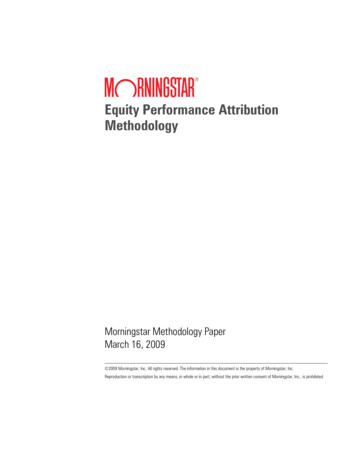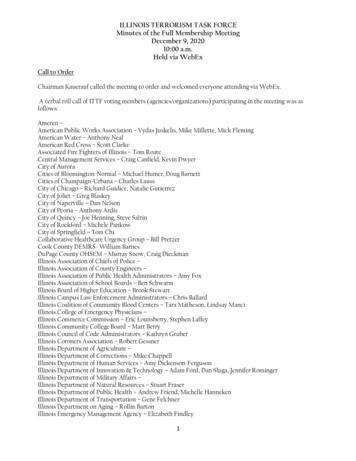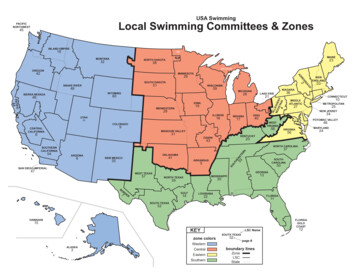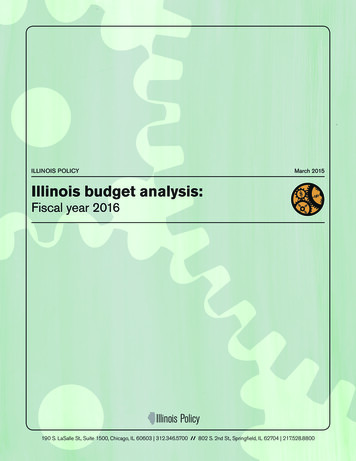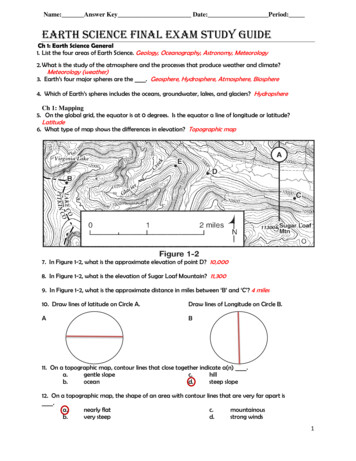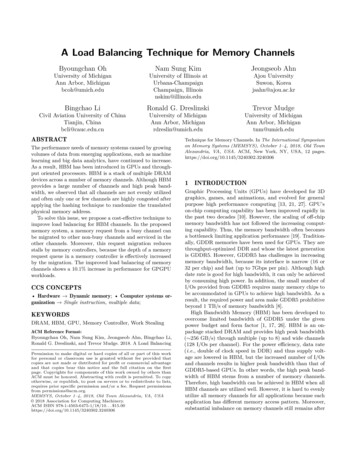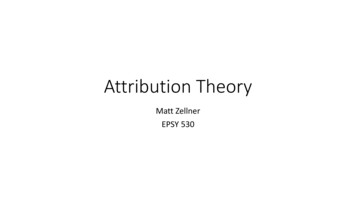
Transcription
Attribution TheoryMatt ZellnerEPSY 530
Where do you attribute your success?Two students take an exam. One of them passes.To what might each of them attribute the outcome?How will that impact the motivation of each student in the future?
What attribution theory assumes The causes individuals attribute to events have an impact on the waythey cognitively, affectively, and behaviorally respond on futureoccasions. People are naive scientists: trying to understand causal determinantsof theirs and other’s behavior. Why things happen, why people say and do things
Relevant to many domains Achievement Affiliation Sports Politics Economics Criminal justice How do attributions explainachievement motivation? How do attributions and theattributional process influencesubdomains in achievement?
What is an attribution? Attributions may or may not be actual causes. Gives precedence to “an individual’s construction of reality.” In line with other constructive cognition/learning theorists: Bruner Piaget Vygotsky
The roots of attribution theory Attribution theory is rooted in the work of Kurt Lewin, Julian Rotter,John Atkinson, Fritz Heider, Harold Kelley, and Bernard Weiner. Heider (1958) argued that people try to identify the dispositionalproperties that underlie observed behavior and do so by attributingbehavior either to: external (situational) causes internal (dispositional) causes.
The roots of attribution theory Key player: Bernard Weiner and his colleagues in the early 1970s. Weiner was a student of Atkinson. 3 dimensional model of attribution theory Attribution theorists investigate the perception of causality, or the judgment ofwhy a particular incident occurred. The allocation of responsibility manifestlyguides subsequent behavior (Weiner, 1972).
Weiner’s attribution theory model Antecedent conditions Perceived causes Causal dimensions Psychological consequences Behavioral consequences
The general attributional model
Antecedent conditions: EnvironmentalSpecific Information & Social Norms Actor-observer information differences Feedback: task, teacher, and more. Task difficulty relative to peers
Consensus, Consistency, Distinctiveness Basic question for perceiver: how to assign causality to the person orthe environment, in light of principle that behavior is both (Kelley,1967). Distinctiveness of entities Consensus across persons Consistency over time and situations Evidence shows that people do not weight all factors equally! Consistency most used Consensus least used
Attributions & the movies If Anne recommends a movie to Roger, he must decide: Is the movie good? (the entity) Does Anne’s recommendation derive from something about her? (the person)What are situations in which Roger might attribute therecommendation to Anne? To the movie?Kelley, 1967 as described in Schunk et al., 2002
Antecedent conditions: Personal factors Causal rules and schemas The various principles and beliefs that individuals have learned about causality theyuse to make attributions Six general principles (Fiske & Taylor, 1991): Causes must precede events. Events that share temporal contiguity with target event are more likely to be seen as causalfactors. Events that spatially contiguous are more likely to be linked in cause/effect relationship. Perceptually salient stimuli more likely to be seen as causal than stimuli in the visualbackground Causes resemble effects. Representative causes are attributed to effects.
Attributional biases Attributional biases Actor-observer perspective - attribute others behavior to disposition, but own tosituation Self-serving bias - accept personal responsibility for success, deny responsibility forfailure People more likely to accept credit for success than deny responsibility for failure (Fiske &Taylor, 1991). Self-centered bias - Regardless of success or failure, people accept more personalresponsibility for joint outcome False consensus effect - individuals come to see their behavior as typical, perhaps byassociating with other with similar views
Fundamental attribution errorClassic study by Jones & Harris, 1967:In each of the experiments the subjects were instructed to estimate the "true” attitude of a targetperson after having either read or listened to a speech by him expressing opinions on acontroversial topic. Independent variables included position of speech (pro, anti, or equivocal),choice of position vs. assignment of position, and reference group of target person. The majorhypothesis (which was confirmed with varying strength in all three experiments) was that choicewould make a greater difference when there was a low prior probability of someone taking theposition expressed in the speech. Other findings of interest were: (1) a tendency to attributeattitude in line with behavior, even in no-choice conditions
Antecedent conditions: Personal factors Prior knowledge and individual differences Rotter (1966) - Locus of control Internals - high contingency between behavior and outcomes Externals - Not a strong link between behavior and outcomes
Learned helplessness Learned helplessness theory addresses individual differences. Perception of little relationship between behaviors and outcomes. These included significantly lower initial estimates of success, less persistence,attribution of failures to lack of ability and of successes to factors beyondpersonal control, and greater decrements in expectancy of success followingfailure. Butkowsky, I. S., & Willows, D. M. (1980). Cognitive-Motivational Characteristics of Children Varying in Reading Ability: Evidence forLearned Helplessness in Poor Readers. Journal of Educational Psychology, 72(3), 408–422. http://doi.org/10.1037/00220663.72.3.408
Perceived causes Early attributional research looked at four causes for success/failure: AbilityEffortTask difficultyLuck Later research included more attribution possibilities These items came from self-reported study data. Ability and effort seen as causes cross culturally.
Content of attributions
Causal dimensions The motivational push of attributions derives from their classificationalong dimensions based on an analysis of their causal structure. Dimensions Stability Internality Controllability All of these impact: Expectancy beliefs Emotions Motivated behaviors
Weiner’s dimensions
Locus dimension Is the cause is internal or external to the individual? Internal Ability Effort External Task difficulty Luck
Stability dimension How stable the cause is over time? Stable versus unstable. Causes: Fixed or variable over situation and time? Better adaptively to not have a purely locus model: we want to think thatinternal effort is unstable cause over stable ability. Globality vs specificity: how many situations does a cause generalize to?
Therd3dimension: Controllability
Controllability dimension How controllable the cause is Controllable versus uncontrollable Are there external controllable causes? Intentionality and controllability According to Weiner, the same thing!
Dimensions & Expectancy BeliefsSome notable findings: Failure: adaptive to attribute to unstable and controllable causes. For attributions to have effects, they must not be discredited by futureoutcomes Realistic ability judgments led to the best performance. Stability dimension more closely linked to expectancy for success than locus
Attributions & Emotions So what about emotions? Attribution theory doesn’t explain emotions. Emotions are really just kinds of attributions. Emotions values from expectancy value theory!
Developmental differences Findings for attribution theory may vary by age. Weiner (1985) described ability as the prototypic example of an internal,stable, and uncontrollable causal attribution, whereas effort exemplifies aninternal, unstable, and controllable attribution. Research shows children do not have the same meanings forattributions as adults!
Nicholl’sdevelopmental stages& concept of ability
Entity versus incremental view of intelligence Nicholls: Relied on Sternberg’s investigations of intelligence. The hardware of how your brain works to achieve goals. Fluid Crystalized Is it possible to look at intelligence as an attribution? Intelligence is a fuzzy concept
Next steps in attribution theory Sandra Graham Follows up on work by Weiner. Looks at aggression and achievement How do we help unstable/external attributors improve performance?
References Butkowsky, I. S., & Willows, D. M. (1980). Cognitive-Motivational Characteristics of Children Varying in ReadingAbility: Evidence for Learned Helplessness in Poor Readers. Journal of Educational Psychology, 72(3), 408–422. http://doi.org/10.1037/0022-0663.72.3.408 Heider, F. The psychology of interpersonal relations. New York: Wiley, 1958. Kelley, H. H. (1967). Attribution theory in social psychology. In Nebraska symposium on motivation. University ofNebraska Press. Malle, B. F. (2004). How the mind explains behavior. Folk Explanation, Meaning and Social Interaction.Massachusetts: MIT-Press. Nicholls, J. G. (1990). What is ability and why are we mindful of it? A developmental perspective. CompetenceConsidered. Rotter, J. B. (1966). Generalized expectancies for internal versus external control of reinforcement. Psychologicalmonographs: General and applied, 80(1), 1. Schunk, D. H., Meece, J. L., Pintrich, P. R. (2014). Motivation in education: Theory, research, and practice (4th Ed.).Boston, MA: Pearson. Weiner, B. (1972). Attribution theory, achievement motivation, and the educational process. Review ofeducational research, 42(2), 203-215. Weiner, B. (1985). An attributional theory of achievement motivation and emotion. Psychological review, 92(4),548.
Achievement Affiliation Sports Politics Economics Criminal justice How do attributions explain achievement motivation? . The psychology of interpersonal relations. New York: Wiley, 1958. Kelley, H. H. (1967). Attribution theory in social psychology. InNebraska symposium on motivation. University of


